Understanding ABA Therapy and Its Impact on Group Participation
Applied Behavior Analysis (ABA) therapy has long been recognized for its effectiveness in supporting individuals with autism, particularly in improving social and functional skills essential for classroom settings. This article explores how ABA therapy enhances group participation in classrooms by fostering communication, social interaction, and independence through evidence-based interventions delivered by qualified professionals.
What is ABA Therapy and How Does It Support Individuals with Autism?
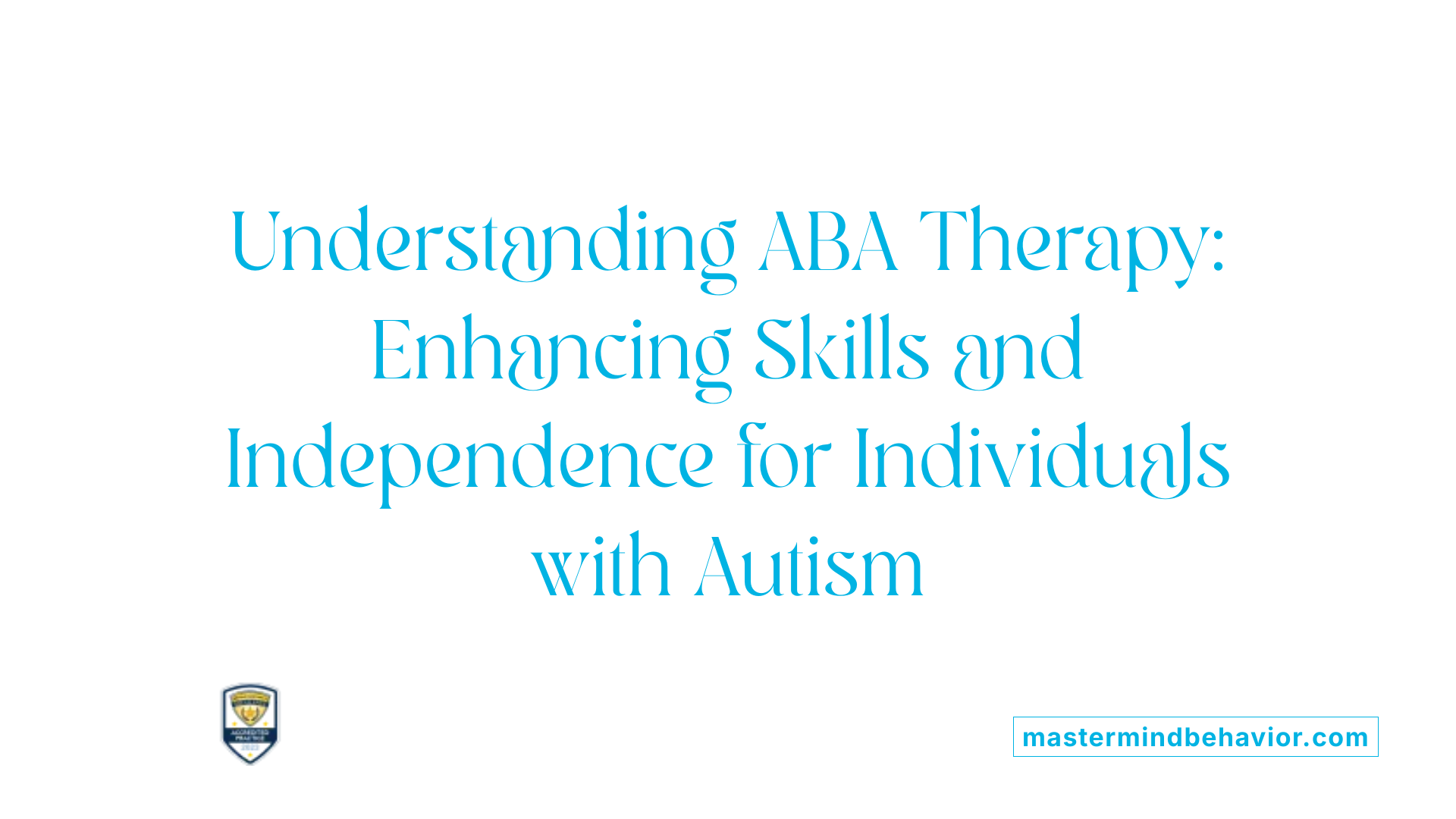
What is Applied Behavior Analysis (ABA) therapy?
Applied Behavior Analysis (ABA) therapy is a treatment that uses behavioral principles to enhance helpful behaviors and reduce harmful ones, primarily for individuals with autism. It is a scientifically supported approach that has been evolving since the 1970s, aiming not to cure autism but to improve daily skills, social interactions, and independence.
How does ABA therapy support individuals with autism?
ABA therapy focuses on increasing positive behaviors such as communication, social skills, and daily living abilities by using the 'ABCs' — antecedent, behavior, and consequence — to understand and modify behaviors effectively. A core method within ABA is positive reinforcement, where desired behaviors are rewarded to encourage their repetition.
What is the focus of ABA therapy?
Instead of addressing autism as a condition to be eliminated, ABA concentrates on skill development. This includes teaching communication alternatives, social skills, and life skills, helping individuals cope and function more independently in various environments.
How is ABA therapy individualized?
ABA programs are tailored to each person's unique needs. Professionals, including Board Certified Behavior Analysts (BCBAs) and Registered Behavior Technicians (RBTs), deliver these therapies using data-driven assessments to customize goals. Early intervention, particularly before the age of six, is highly beneficial, promoting significant developmental gains.
What are the benefits of early intervention with ABA?
Starting ABA therapy early maximizes progress in language, socialization, and self-regulation skills. Parental involvement and ongoing data collection are crucial to adapt strategies and maximize long-term success, allowing individuals with autism to participate fully in their communities.
Key Roles and Qualifications of ABA Therapy Professionals

Who provides ABA therapy and what qualifications do these professionals typically have?
ABA therapy is delivered by a range of trained professionals, each with specific qualifications ensuring effective treatment tailored to individual needs. The most highly trained practitioners are Board Certified Behavior Analysts (BCBAs). BCBAs have advanced graduate-level education in behavior analysis, allowing them to conduct detailed assessments, develop personalized treatment plans, and supervise therapy programs.
Registered Behavior Technicians (RBTs) serve as skilled paraprofessionals who implement ABA interventions under the close supervision of BCBAs. RBT certification involves specialized training to apply behavior-analytic procedures effectively and ethically.
Other qualified professionals, such as Board Certified Assistant Behavior Analysts (BCaBAs) and designated paraprofessionals, play supporting roles within therapy teams. Their training equips them to assist in providing high-quality ABA services.
What are the roles of different professionals in ABA therapy?
- BCBAs: Design individualized interventions, carry out assessments, supervise therapy, and train other team members.
- BCaBAs: Assist BCBAs in assessment and intervention and may oversee RBTs.
- RBTs: Deliver direct therapy, collecting data and reinforcing skill development.
- Qualified paraprofessionals: Support therapy implementation under professional guidance.
Why is specialized training important in ABA therapy?
Specialized training ensures professionals understand the nuances of behavior analysis, including concepts like the ABC model (Antecedent, Behavior, Consequence) and positive reinforcement. This knowledge helps them create interventions that are evidence-based and effective for clients with autism and other conditions. Proper qualifications ensure therapy is safe, ethical, and scientifically sound.
How does specialized training ensure quality therapy delivery?
Trained professionals systematically observe behaviors, identify triggers, and use research-backed techniques to encourage growth. Their expertise allows the design of tailored plans that address individual challenges and promote independence. Through certification and continuous education, these experts remain current on best practices, enhancing therapy outcomes.
Together, the dedicated and credentialed team members of ABA therapy provide structured, validated care that supports individuals across various life stages, ensuring interventions are both compassionate and scientifically grounded.
Fundamental Principles Underpinning ABA: The ABCs and Positive Reinforcement
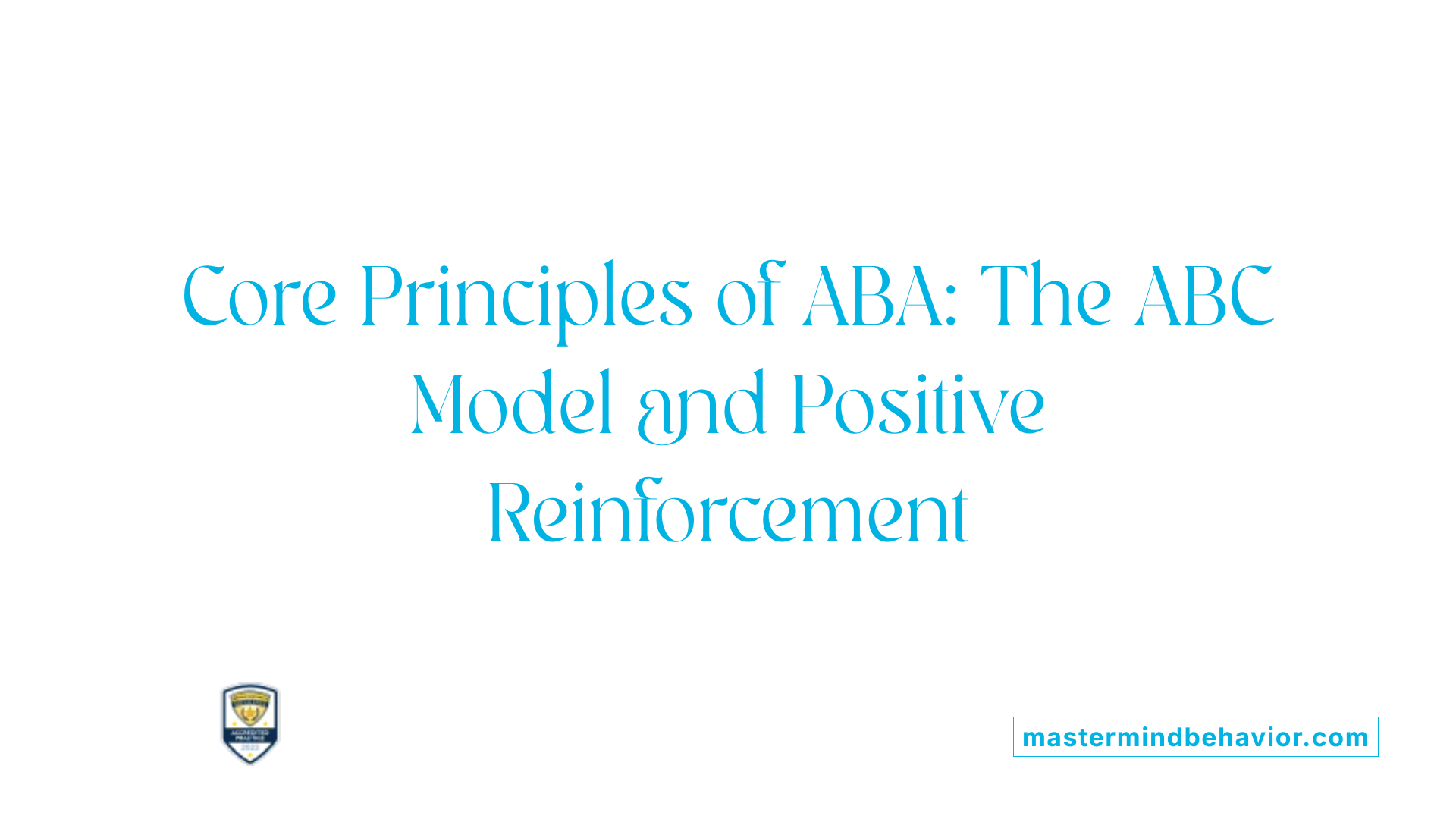
What is the Antecedent-Behavior-Consequence Model?
The ABC model is foundational to ABA therapy and involves three components: antecedent, behavior, and consequence. The antecedent is what happens immediately before a behavior, essentially the trigger or cue. The behavior is any observable action by the individual. The consequence follows the behavior and determines whether the behavior is likely to occur again. Understanding this sequence allows therapists to analyze the reasons behind behaviors and develop strategies to modify them.
How Does Positive Reinforcement Work in ABA?
Positive reinforcement is a core element of ABA that aims to increase desired behaviors. When a behavior is followed by a rewarding consequence, such as praise, a preferred activity, or tangible rewards, it encourages the individual to repeat that behavior. This approach is effective in teaching new skills and promoting helpful behaviors over harmful or unproductive ones.
What Behavior Modification Techniques Are Employed?
Behavior modification within ABA uses the ABC framework to identify triggers and consequences shaping behaviors. By adjusting antecedents and delivering positive reinforcements, therapists can encourage beneficial behaviors and reduce problematic ones. Techniques include teaching alternative responses to challenging behaviors and using consistent rewards to strengthen skill acquisition and social interactions.
How Is ABA Applied in Classroom Environments?
In educational settings, ABA principles guide classroom management and instruction for students with developmental disabilities. Teachers and paraprofessionals use the ABC model to observe and respond to behaviors, applying positive reinforcement to encourage participation and learning. ABA-based strategies help improve academic skills and promote independence, aiming for successful reintegration into traditional classrooms when possible.
Typical Goals and Measurable Outcomes of ABA Therapy in Educational Settings
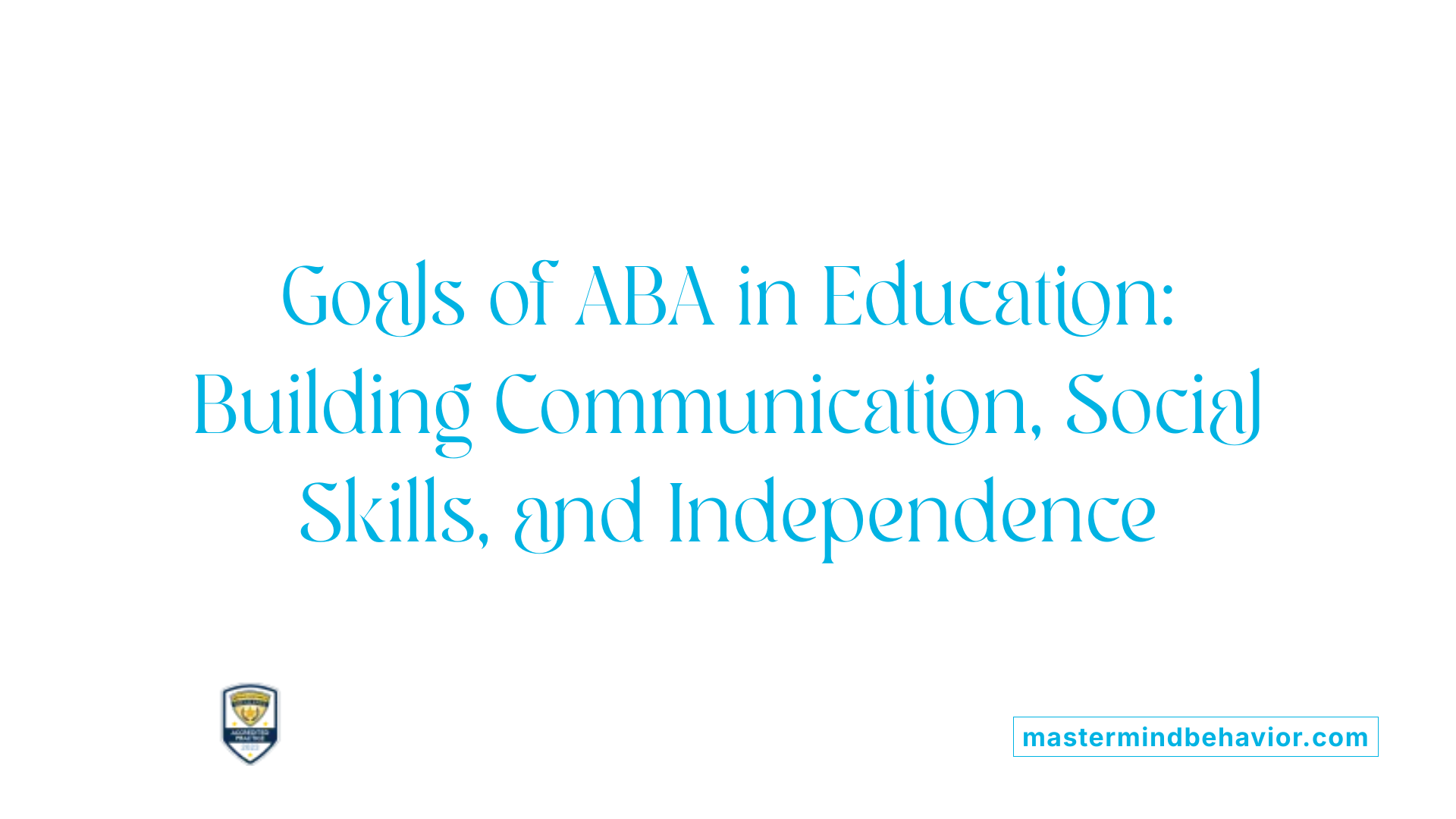
What are the typical goals or outcomes that ABA therapy aims to achieve for individuals with autism?
ABA therapy focuses on meaningful behavior change tailored to each individual's needs. In educational settings, the goals center on enhancing communication, improving social interaction, and developing independence.
Communication Enhancement
One major goal is to build functional communication skills. This includes teaching both expressive communication—like using speech or alternative methods such as gestures and communication devices—and receptive skills, which support understanding instructions and social cues.
Social Interaction Improvement
ABA therapy encourages positive social behaviors, helping students engage appropriately with peers and adults. This can involve skills such as turn-taking, understanding social norms, and initiating or responding in conversations.
Independence Development
Fostering independence is a vital outcome, where individuals learn daily living skills and self-care routines. In classroom settings, this can include managing personal belongings, following schedules, and completing tasks with minimal assistance.
Reducing Challenging Behaviors
ABA targets decreasing harmful or disruptive behaviors by identifying triggers and replacing them with constructive alternatives. This often uses positive reinforcement to reward desirable behaviors.
Functional Skills in the Classroom
Educational goals also encompass developing academic skills tailored to the student's level, such as reading, writing, and numeracy, alongside practical skills necessary for classroom participation.
Academic and Community Participation
Beyond academics, ABA promotes broader participation by teaching skills needed for successful integration into community activities and peer groups, enhancing overall quality of life.
ABA therapy’s success is measured by clear, individualized objectives and periodic assessment, ensuring progress toward social, communicative, academic, and independence milestones.
Measuring Progress and Effectiveness of ABA Therapy in Group Settings
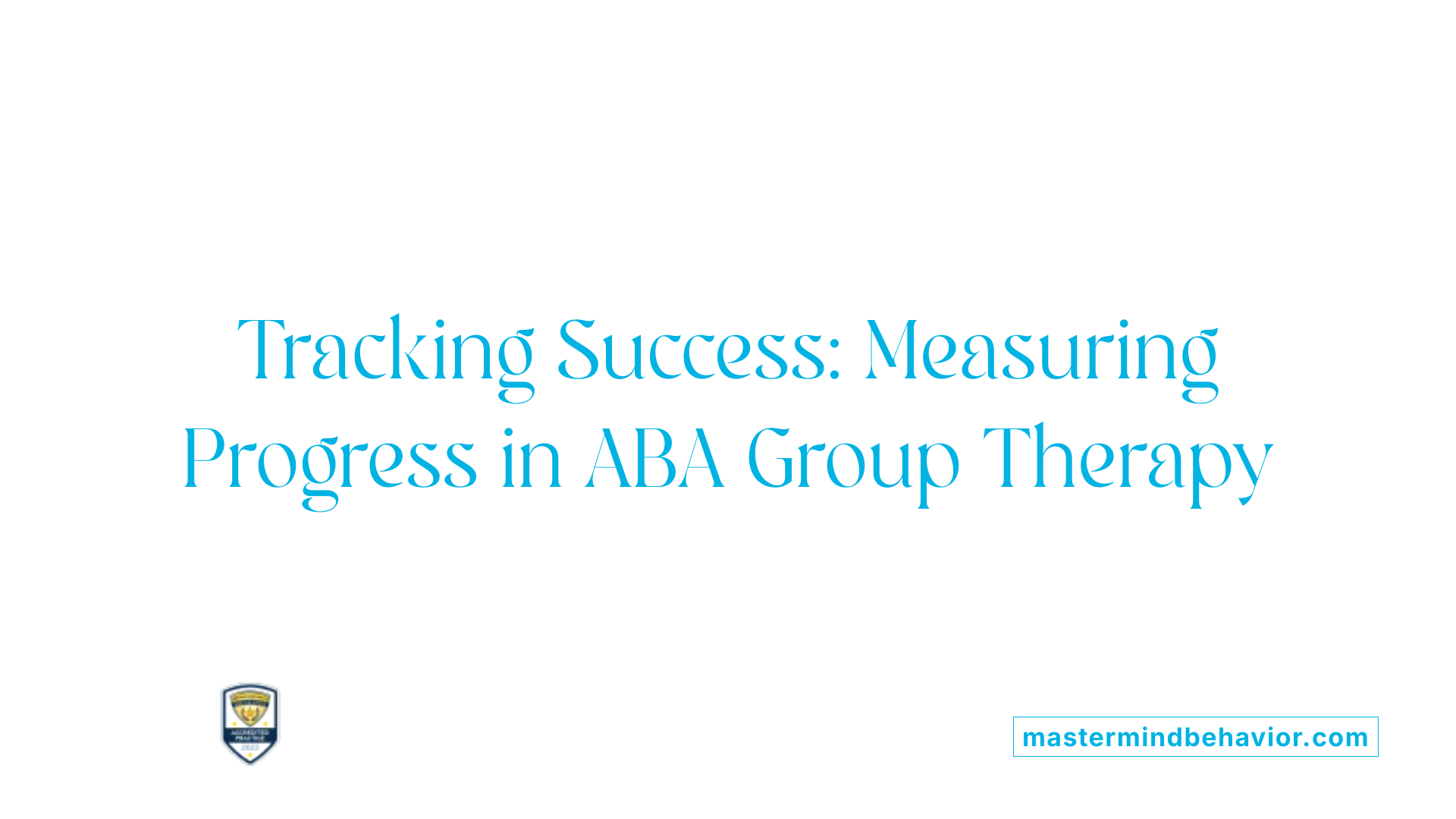
How is the effectiveness of ABA therapy measured and evaluated in treatment plans?
ABA therapy relies heavily on systematic data collection to measure progress. Professionals like BCBAs gather detailed records of behaviors, tracking how often and under what conditions certain actions occur. This data collection can be continuous—capturing every behavior instance—or discontinuous, observing in set time frames.
Data collection and analysis
This data is analyzed to identify trends in desired behaviors such as communication, social interaction, and emotional regulation. For example, increases in spontaneous communication or longer periods of calm are carefully recorded.
Tracking behavioral changes
Quantitative data allows therapists and educators to objectively see improvements or areas needing more focus. Positive changes like more frequent use of words, reduced tantrums, or improved independence are noted regularly to guide treatment.
Assessment tools
Assessment tools include single-case research designs that monitor an individual's response to specific interventions over time. CABER, for instance, uses such methods to gauge immediate behavioral effects and adjust techniques accordingly.
Role of supervisors and educators
Licensed supervisors coordinate with classroom educators to ensure ABA strategies are consistently applied. Teachers support therapy by reinforcing new skills during daily activities, enhancing generalization of behaviors across settings.
Adjusting therapy plans based on data
Regular review of collected data enables therapists to customize interventions, increasing or changing supports as needed for greater effectiveness. This dynamic approach ensures therapy evolves with the individual's needs.
By combining precise measurement with skilled supervision, ABA therapy in group settings becomes a data-driven, adaptable process that promotes meaningful, observable progress in clients' lives.
Applying ABA Strategies to Improve Classroom Group Participation
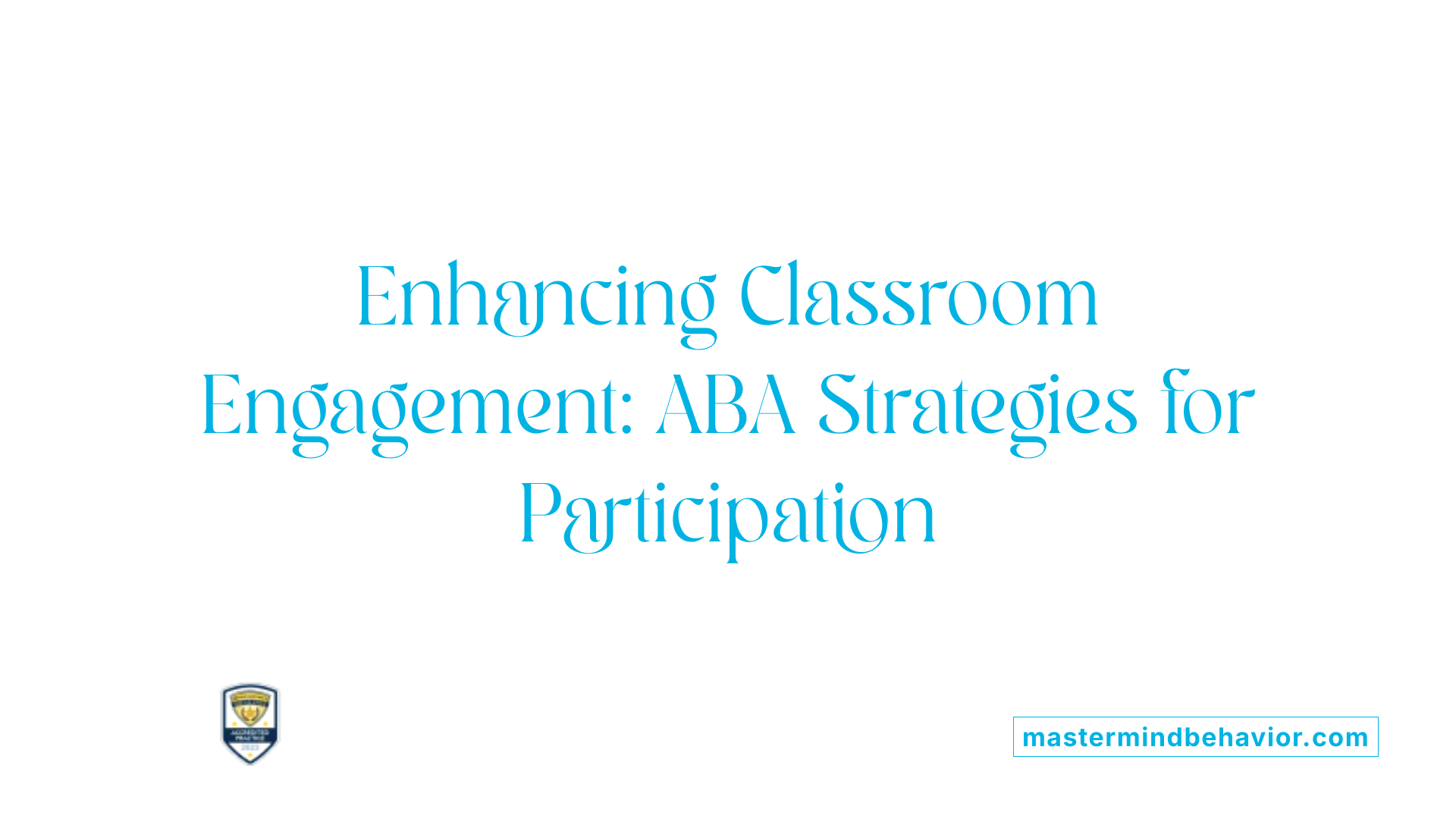
How does ABA therapy support classroom participation?
ABA therapy employs targeted strategies to enhance students' participation in group classroom settings, especially those with developmental disabilities. A primary focus is on reinforcing social engagement through positive reinforcement, encouraging students to interact and collaborate during group activities.
What classroom support techniques does CABER implement?
At CABER, professionals use evidence-based ABA methods to observe classroom behaviors, identify triggers for disruptive actions, and apply individualized interventions. This might involve adjusting environmental antecedents to prevent challenging behaviors and teaching new skills that promote cooperation and participation.
How is communication training incorporated?
Functional Communication Training (FCT) is a cornerstone technique used to improve group participation. By replacing disruptive behaviors with effective communication methods—including vocal responses, gestures, or devices like iPads—students can better express needs and engage meaningfully with peers and teachers.
How are disruptive behaviors reduced?
Through careful analysis of antecedents and consequences, ABA therapists develop strategies that minimize disruptive behaviors. Positive reinforcement strategies reward appropriate social behaviors, decreasing interruptions and improving overall classroom dynamics.
How does ABA promote independence during group activities?
ABA emphasizes skill acquisition, encouraging students to perform tasks independently within group settings. Support may include step-by-step guidance, modeling, and reinforcement of self-initiated participation, gradually preparing students for less supported involvement.
How are students integrated into traditional classrooms?
CABER's direct educational services aim to build academic and life skills, supporting transitions from specialized settings to mainstream classrooms. Using ABA principles, students receive tailored support to successfully navigate group activities alongside their peers, fostering inclusivity and independence.
Functional Communication Training and Its Role in Group Dynamics

What Is Functional Communication Training (FCT) and How Does It Work?
Functional Communication Training (FCT) is a vital ABA-based technique designed to replace challenging behaviors with appropriate and effective communication methods. Instead of focusing on simply reducing unwanted behaviors, FCT identifies the triggers that lead to these actions and teaches individuals alternative ways to express their needs or feelings.
How Does FCT Replace Challenging Behaviors?
By targeting the antecedents that prompt challenging behavior, FCT helps individuals develop functional communication skills that serve the same purpose. For example, a person might learn to request a break or express discomfort through a vocal statement, gesture, or communication device.
What Communication Methods Are Used in FCT?
FCT incorporates a range of communication methods tailored to individual needs. Speech and gestures are commonly taught, enabling spontaneous and direct interaction. Additionally, technology such as iPads or speech-generating devices is often used, especially for those with limited verbal ability, to enhance communication efficiency and clarity.
What Impact Does FCT Have in Classroom Communication?
Within classroom settings, FCT facilitates improved interaction between students and educators, reducing behavioral disruptions and promoting learning engagement. It supports students with moderate to severe intellectual and developmental disabilities by providing communicative alternatives that enable active participation and social inclusion.
How Is Collaborative Research Advancing FCT Effectiveness?
CABER actively participates in NIH-funded research focused on enhancing the long-term success of FCT. By studying different modes of communication—speech, gestures, and devices—and their effects, researchers aim to refine intervention strategies and maximize positive outcomes in diverse settings, including group classrooms and community environments.
Addressing Criticisms and Limitations of ABA in Educational Contexts
Are there any criticisms or limitations of ABA therapy that should be considered?
While ABA therapy has proven benefits, it also faces some criticisms, especially in educational settings. One concern is that the therapy may sometimes be too rigid or repetitive, focusing heavily on compliance. This approach can unintentionally suppress natural behaviors and emotional expression, which are important for an individual's well-being.
Another significant issue is that traditional ABA methods may aim to eliminate behaviors labeled as undesirable without fully considering the individual’s perspective. This could cause distress or feelings of trauma if therapies are applied without sensitivity to the person’s emotional health.
Critics also highlight that ABA might promote neurotypical standards, potentially overlooking the value of neurodiversity. Instead of only trying to change behaviors to fit into typical expectations, some advocate for approaches that emphasize individual strengths and natural development.
Furthermore, not all ABA therapy is the same—its quality can vary depending on the therapist or facility. Some individuals respond better to other therapies or complementary supports, underscoring the need for personalized treatment plans.
Overall, these concerns highlight the importance of tailoring ABA therapy carefully. Respecting each person’s preferences, emotional well-being, and neurodiversity helps make the therapy more effective and humane, particularly in educational settings where development and personal growth are central.
Comprehensive Support Across Life Stages: The Role of ABA in Transition and Adult Services
How Does Early Intervention Using ABA Benefit Individuals?
Early intervention is critical in supporting individuals with developmental disabilities. Using ABA methods, professionals at CABER observe environments and behaviors to identify triggers and apply strategies that help young children develop essential skills early on. This foundational support promotes better long-term independence and social functioning.
What Support Is Available in Classroom and Academic Settings?
CABER provides direct educational services tailored for students with moderate to severe intellectual and developmental disabilities. Their support includes teaching academic and life skills, leveraging research-based tools to enhance classroom read-aloud instructional practices. The goal is to foster growth and prepare students for potential reintegration into traditional classrooms.
How Does ABA Assist in Transition Periods?
Transition assistance is an integral part of CABER’s services, helping individuals navigate from childhood to adolescence and adulthood. ABA strategies continue to be applied to promote skill development and reduce challenging behaviors during these changes, ensuring continuity and stability.
What Adult Support Services Are Offered?
For adults, CABER offers behavioral consultation in supported community settings. These services focus on reducing severe behaviors and encouraging greater independence using ABA principles. Group support facilitates social engagement and ongoing skill enhancement tailored to adult needs.
Why Is Continuity of ABA Benefits Important Across Life Stages?
ABA’s effectiveness lies in its adaptability throughout a person's lifespan. By applying ABA techniques consistently—from early intervention through adulthood—CABER helps sustain progress, address emerging challenges, and support evolving goals.
What Broader Applications of ABA Extend Beyond Autism?
While ABA is well recognized for autism treatment, its principles also benefit people with traumatic brain injuries, substance abuse issues, and are used in education and sports psychology. This broad utility highlights ABA’s capacity to improve behaviors and skills in diverse populations.
CABER exemplifies comprehensive, evidence-based care rooted in ABA, offering tailored support that adapts to individuals' changing needs across life stages and settings.
The Transformative Impact of ABA Therapy on Classroom Participation
ABA therapy plays a pivotal role in improving classroom group participation for individuals with autism by providing structured, individualized strategies that enhance communication, social skills, and independence. Delivered by qualified professionals and grounded in decades of research, ABA's evidence-based interventions enable students to navigate social interactions and academic demands more effectively. While mindful of its limitations and criticisms, ongoing advances and tailored applications of ABA reinforce its value in creating inclusive, supportive educational environments. Continued collaboration among therapists, educators, families, and researchers promises to further empower students with autism to thrive within classroom communities.
References
- Debunking 7 Common Myths About ABA Therapy - GSEP Blog
- A lifetime of support: How CABER uses science and service to ...
- Applied Behavior Analysis (ABA)
- ABA Therapy Goals: 25 Practical Examples & Timelines
- Applied Behavior Analysis (ABA)
- Setting Realistic ABA Therapy Goals | Childwise
- The Importance of ABA Therapy Goals
- How to Set ABA Goals: A Step-by-Step Guide for Success









